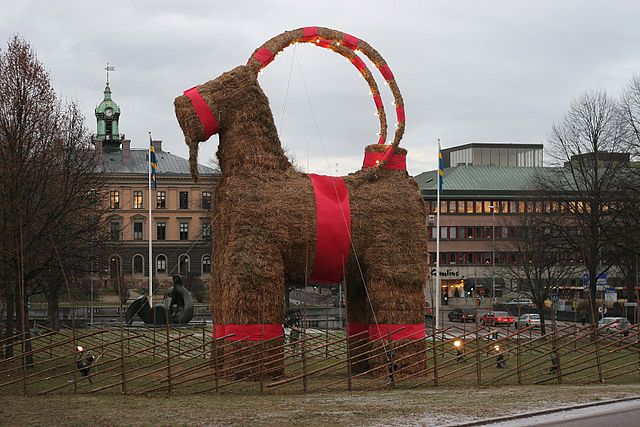Getting the Goat

There are many Christmas traditions around the world, and most of them (if one excludes mass carnage at U.S. retail locations on Black Friday), are imbued with the spirit of giving and community. And Gavle, Sweden (here’s a map) has a tradition which, kind of, fits this mold. Every year since 1966, an association of merchants come together and build the Gavle Goat, a 13 meter (43 feet) tall, 7 meter (23 feet) long yule goat made out of straw, as seen above.
And just about every other year, someone else burns it down, as seen below.
Yule goats — tiny ones, typically used as ornaments — have been part of the Swedish Christmas tradition since the early 19th century, with origins perhaps dating as far back as the 11th century. In 1966, a Swedish ad man named Stig Gavlen and his brother Jorgen, the city’s fire chief, decided to take the tradition and make it the centerpiece of their town’s celebration. The pair created what the Gavle Tourist Office now calls “The biggest Christmas Goat in the world” (which one doubts is a competitively determined title). The goat, which weighed 3.5 metric tonnes (just under 8,000 pounds) was intended to be a new tradition for the city, but vandals started a tradition of their own. As reported by the Telegraph, at the stroke of midnight on New Year’s Eve, someone lit the goat on fire. It burned to the ground.
The goat avoided a similar fate in 1967 and 1968, but again, on New Year’s Eve 1969, the goat was set ablaze. In 1970, the goat did not even make it to New Year’s Eve — it was torched just a few hours after its construction. The merchant group took 1971 off, but a smaller goat was built by a school — it, too, was destroyed. The merchants took the cause back over in 1972 and since, and the goat was destroyed again — Cityguide Europe calls it “sabotage. ”
In the forty years since then, the goat has been burnt many times over, smashed, struck by a car, and attacked with fireworks. Most efforts to stop the destruction clearly failed, but it was not due to lack of trying. For example, in 1985, local soldiers were tasked with guarding the goat, but were unsuccessful, as it was burned down in January. More recently, organizers have turned to technology to protect the goat — via a web cam. People around the world can “tune in” to see the goat whenever they want, and officials hope that the 24-hour surveillance will deter arsonists.
But all the web cam seems to do is capture its seemingly inevitable destruction on video. Take, for example, this past Christmas season. The goat lasted only ten days, until the video above happened.
Bonus fact: According to the New York Times, goat meat is the most commonly eaten type of meat (by people) in the world.
From the Archives: Google’s Lawn Mowing Goats: Greener than a lawnmower, I guess.
Related: Roughly six-and-a-half pounds of straw. At about $25, it’ll only cost you about $30,000 to build a really big goat.
